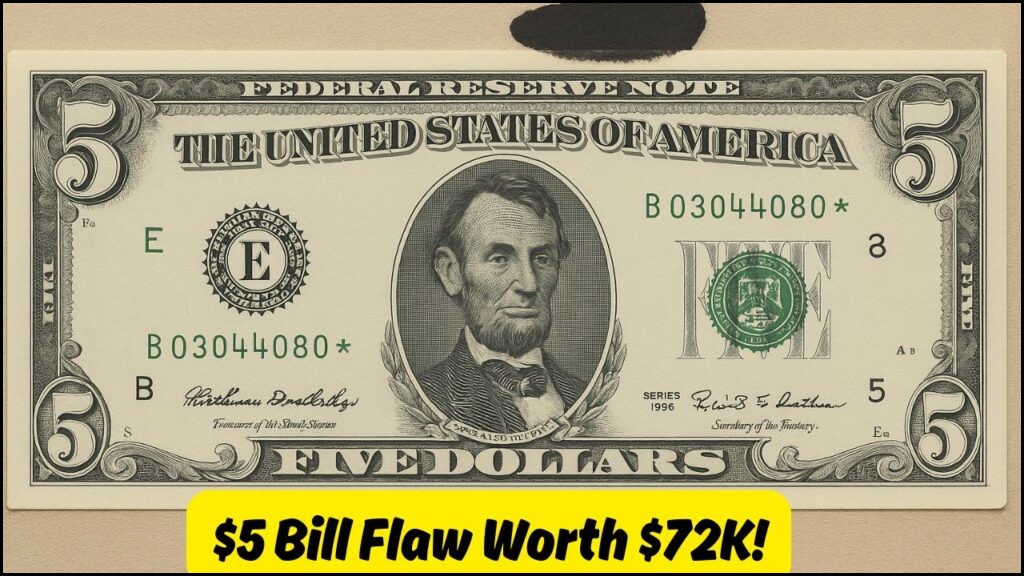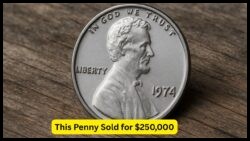1986 $5 Bill – Collectors and currency enthusiasts around the world are buzzing with excitement over a rare 1986 $5 bill that recently sold for a jaw-dropping $72,000. What sets this note apart isn’t gold plating or celebrity association — it’s a printing flaw that went unnoticed by the public for years. In this detailed article, we’ll explore what this error is, how it happened, why it’s so valuable, and how you can check your old notes to see if you’re holding a hidden treasure. This isn’t the first time a U.S. currency note has fetched such a high amount, but what makes this case special is its relatability. Millions of $5 bills were printed in 1986, and only a few may have carried this particular printing flaw. If you’ve ever held onto old currency thinking it might be valuable one day, now is the time to look through your drawers, wallets, or even childhood piggy banks. You might just be in luck. Let’s break down everything you need to know about this incredible find and how to identify if you have one of these high-value bills in your possession.
What Is the Rare Printing Flaw on the 1986 $5 Bill?
A few 1986 $5 bills were discovered with a misalignment error and doubled printing, making them extremely rare in the world of paper currency collecting.
- The most notable flaw was a misprinted serial number — slightly off-positioned and overlapping the seal.
- In some cases, the federal seal or treasury seal was shifted noticeably.
- The printing plates used during this run showed a slight shadowing or doubling in the ink placement.
- These flaws occurred during a specific series printed at the Bureau of Engraving and Printing in Washington, D.C.
- Experts believe that only a few dozen bills like this made it into circulation.
Such bills are now known as “error notes” and are considered prized possessions in the collector’s market due to their rarity and condition.
How Much Was the Bill Sold For?
The rare $5 note made headlines when it sold at an auction for $72,000 in early 2025, drawing massive interest in old currency errors.
| Year Sold | Auction House | Final Bid | Condition | Grading Agency |
|---|---|---|---|---|
| 2025 | Heritage Auctions | $72,000 | Almost Uncirculated | PCGS Currency |
| 2023 | Private Sale | $45,000 | Fine | PMG |
| 2021 | eBay Collector Lot | $21,000 | Good | Ungraded |
The more pristine the condition, the higher the payout. Bills that are uncirculated or professionally graded are most likely to receive premium offers.
How to Spot the Valuable 1986 $5 Bill in Your Collection
If you’re curious whether you might own one of these rare bills, here are the exact steps to follow when inspecting your 1986 $5 bills:
- Look at the serial number: Is it crooked, duplicated, or overlapping the seal?
- Examine the seal placement: The green or black seal should be neatly printed — any shift is a red flag.
- Check for ink doubling: Use a magnifying glass to spot shadows or repeated print areas.
- Inspect the overall alignment: If the edges or borders seem uneven or skewed, it could be a misprint.
- Look for red or blue fibers: Some error notes also contain visible colored threads, though rare.
Don’t assume your bill isn’t worth checking — many owners of rare currency had no idea what they were holding.
Where and How to Get Your Bill Verified and Sold
If you believe your 1986 $5 bill could be a rare error note, you’ll need to authenticate and appraise it.
- Step 1: Visit a professional currency grading agency like PMG (Paper Money Guaranty) or PCGS Currency.
- Step 2: Submit your bill through their evaluation process.
- Step 3: Get it professionally graded and certified.
- Step 4: Consider selling it at reputable auction houses such as Heritage Auctions or Stack’s Bowers.
- Step 5: Alternatively, list it on trusted collector platforms like eBay Collectibles or GreatCollections.
Grading can cost between $25–$100, but dramatically increases your chance of a successful and high-value sale.
Other Valuable Error Notes to Look Out For
This isn’t the only U.S. bill to have skyrocketed in value due to a simple mistake. Below are other famous error notes that could be hiding in someone’s pocket:
| Note Type | Error Description | Approx. Value (High) | Year |
|---|---|---|---|
| 2006 $1 Note | Inverted Overprint | $25,000 | 2006 |
| 1988A $10 Bill | Missing Seal and Serial | $14,000 | 1988A |
| 1995 $20 Note | Double Denomination | $35,000 | 1995 |
| 2013 $100 Bill | Printed Without Serial # | $28,500 | 2013 |
| 1977 $1 Bill | Misaligned Cut | $9,800 | 1977 |
These notes often go unnoticed and enter everyday circulation, making them hidden treasures for keen-eyed collectors.
Final Tips Before You Search Your Bills
Before diving into your old bill stash, remember that not every odd-looking note is worth thousands. But it only takes one rare bill to change your financial luck.
- Keep your old notes flat and safe — don’t fold or tape them.
- Store them in currency sleeves if you suspect value.
- Avoid cleaning or altering the note — it can reduce the value drastically.
- Join collector groups or forums for guidance and comparison photos.
- Check the serial number ranges and printing facility codes from collector databases.
Even if your note isn’t the $72,000 jackpot, it could still fetch hundreds or thousands if it has a less rare error.
FAQs About the 1986 $5 Error Bill
Q1. What makes the 1986 $5 bill worth $72,000?
A rare printing error, including misaligned seals and duplicated serial numbers, made the bill a highly valuable collector’s item.
Q2. How many of these flawed bills are known to exist?
Only a handful have been identified and confirmed, possibly fewer than 50 worldwide.
Q3. Can I sell my bill without getting it graded?
Yes, but grading increases its value and authenticity, making it more attractive to serious collectors.
Q4. Where can I get my bill graded?
Trusted agencies include PMG (Paper Money Guaranty) and PCGS Currency. Submission can be done online or through dealers.
Q5. What if my 1986 bill has no flaws?
Without a flaw, it’s likely worth only face value unless it’s in mint condition or has a rare serial number.






